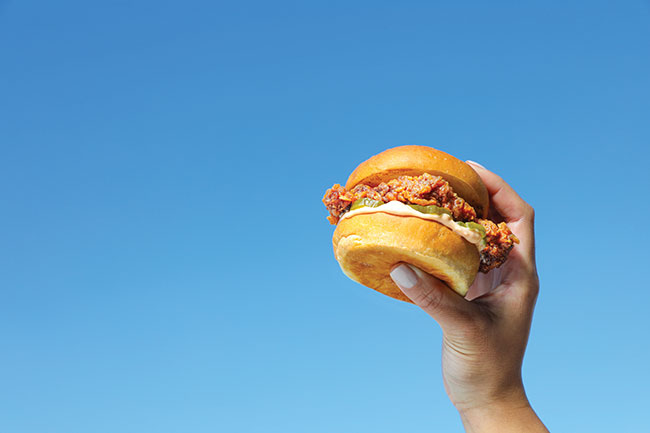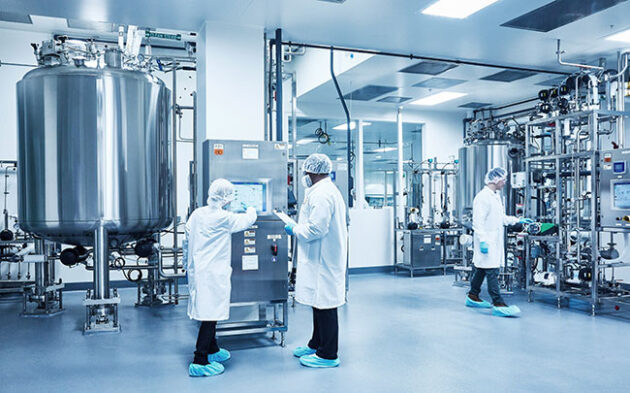
From lab to table: the rise of cell-cultivated chicken
By Treena Hein
Features Emerging TrendsCell-cultivated chicken hit a few big milestones this year. Here's a look at how it’s made, new products, regulatory updates and more.
 Two California-based firms, GOOD Meat and UPSIDE Foods, recently received approval to sell their cell-cultivated chicken in the U.S.
Photo: UPSIDE Foods
Two California-based firms, GOOD Meat and UPSIDE Foods, recently received approval to sell their cell-cultivated chicken in the U.S.
Photo: UPSIDE Foods Whatever consumers think of cell-cultivated chicken at this point – in terms of food safety, eating experience, cost, animal welfare, environmental impact and many other factors – it’s already available at two U.S. restaurants, with rollout to expand across the country in restaurants and then grocery stores.
Two California-based firms, GOOD Meat and UPSIDE Foods, received approval from the U.S. Department of Agriculture to sell their cell-cultivated chicken, which is the approved label term.
Before we look at the process and more, let’s review some other developments. As far back as 2020, U.S.-based cultivated meat developer Mission Barns offered the public stateside the chance to try bacon grown from pig cells. In July this year, the Netherlands government announced that it will allow cultivated meat and seafood to be taste tested.
Also this summer, global beef producer JBS SA announced it’s building the world’s biggest cultured meat plant in Spain. It will be owned by cell-cultivated meat firm BioTech Foods, which is majority owned by JBS SA. The facility will cost $41 million USD and is expected to be finished next year. JBS SA is also planning to build a $60 million USD-research institute in southern Brazil to develop cellular agriculture technology.
BioTech did not respond to inquiries about what types of cell-cultivated meat will be produced at the plant in Spain or other matters, but media reports indicate 1,000 metric tons of product will be produced per year, with capacity to expand to about four times that.
U.S. companies
GOOD Meat is the world’s first-to-market cell-cultivated meat company, and has been selling its products in Singapore for about three years. UPSIDE is owned by egg substitute company Eat Just.
To celebrate and launch their cell-cultivated chicken products, both firms recently hosted splashy dinners for the media and select paying customers in renowned restaurants with famous chefs. At a restaurant in San Francisco, tempura-fried UPSIDE cell-cultivated chicken was served with a burnt chili aioli. In Washington, D.C., diners sat down to enjoy charcoal-grilled GOOD Meat cell-cultivated chicken marinated with anticucho sauce.
GOOD Meat’s products are pre-cooked and come in shapes such as cutlets. “When we process our chicken into a finished product, we use heat and pressure to do so, which cooks the meat,” says Carrie Kabat, the company’s consumer communications director. “The [product] is then frozen to extend its shelf life.”
UPSIDE’s current filet product is not pre-cooked. “In the future, it’s possible we will have products that are both pre-cooked and not pre-cooked,” explains a spokesperson.
The production process
The overall process involves selecting cells from a live bird or a cell bank and placing them in vats to grow and divide in a solution of amino acids, sugars, carbohydrates, vitamins and other nutrients.
UPSIDE uses cells from fertilized chicken eggs, and harvest takes place in two or three weeks. GOOD Meat uses fibroblasts (a type of cell that contributes to the formation of connective tissue) and cell banks as the starting point, with product ready in four to five weeks.
At this point, production at both firms is small, but scale up is coming. GOOD Meat can currently produce tens of thousands of pounds per year, but Kabat says “by the end of this decade, we aim to produce tens of millions of pounds…per year.”
She adds that at this point, GOOD Meat is not making a profit on products sold to restaurants, but “that will change as we tackle some the remaining technical and engineering hurdles inherent in large-scale commercial production.” They are working to decrease the cost of the growth solution and increase cell density, among other tasks.
UPSIDE can currently produce over 50,000 pounds of meat per year, with a future capacity at the present facility of over 400,000 pounds. The spokesperson reports “we’re currently in the site selection and design process of a larger-scale commercial facility that will be capable of producing millions of pounds per year.”
Right now, UPSIDE’s products are offered at a premium price, but its ultimate goal is to offer products that are more affordable than conventionally produced meat. Similarly to GOOD Meat, there is a focus on reducing the cost of the nutrient solution and finding other efficiencies in scaling up.
“We’ve already made tremendous progress on both of these fronts,” says the spokesperson, “and continue to invest in developing and testing new production processes to help achieve these goals.”
Rollout and acceptance
UPSIDE plans to partner with additional chefs and restaurants in the short term, while GOOD Meat plans to do the same things it’s already done to successfully develop its market in Singapore.
“There, our chicken has been featured on menus at fine dining establishments, popular hawker stalls, via the ‘foodpanda’ delivery platform and most recently by reservation at Huber’s Butchery, one of Singapore’s premier producers and suppliers of high-quality meats,” Kabat reports. “Thousands of dishes, ranging from crispy strips and curries to skewers and salads, have been sold in Singapore, and have received universally high marks from diners.”

Pictured is the plant where GOOD Meat develops its cell-cultivated chicken.
Photo: GOOD Meat
Exposure to product is key
Making the product available to try is a critical aspect to the GOOD Meat marketing plan. “Based on what we’ve seen in Singapore and in private tastings at our headquarters in the San Francisco Bay Area,” Kabat says, “we know that tasting is believing, so we want to allow as many people as possible to try our [product].
“As more people try it and enjoy it, the more accepted it will become. We believe there will be high demand for [cell-cultivated] meat in the years to come. We envision a world where consumers will have a choice between conventionally produced meat, [cell-cultivated] meat and plant-based meat.”
Similarly, UPSIDE wants its products to be available everywhere normal meat is sold, with the public viewing it as equally suitable for enjoying at a Michelin Star restaurant or a backyard barbeque.
“Education is a top priority,” says the UPSIDE spokesperson. “We recognize it will take time for people to come around to this new way of making meat. That means our job, from a communications perspective, is to have conversations like the one we are having now, and to make sure consumers have access to the facts.
“At that point, we trust people to make the purchasing decisions that make the most sense for them – and we think many of them will choose cell-cultivated meat because of the value add. Ultimately, the real magical moment happens when someone sees the [cell-cultivated] meat, hears it sizzling and tastes it. The more these moments happen, the greater consumer enthusiasm will be.”
Interestingly, the cells used to produce UPSIDE chicken come from a heritage chicken breed. This is not surprising, as many people view heritage chicken meat as much more flavourful than that of conventional commercial chickens.
When asked about his views on consumer appetite for cultivated chicken, JJ Hochrein, director of brand marketing at Chicken Farmers of Canada, says that while it’s captured a lot of media attention, “other than the curiosity factor, it is unclear if consumers will really want to consume it on a regular basis.”
He adds that “the environmental impact of cell-cultivated chicken is still unknown and can make cell-cultivated meat not acceptable to consumers, especially for chicken, which has the lowest carbon footprint of all livestock.”
Print this page